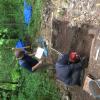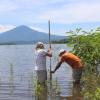Ancient Explorers of Cyprus: Traversing Land and Sea in the Epipalaeolithic (2018 Season)
Although the Mediterranean islands produced some of the most sophisticated cultures of the ancient world, until recently there was little evidence that these islands were occupied prior to the Neolithic. This perception has radically changed over the past decade. New research indicates that some remote islands, such as Crete and Naxos, may have been occupied by Neanderthals, and certainly by the Epipaleolithic it appears that continental-island voyages were far more common than previously believed.










